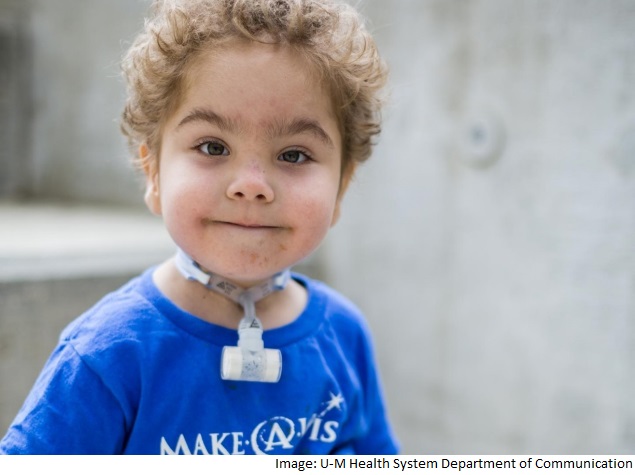- Home
- Science
- Science News
- 3D Printed Splints Help Infants With Airway Disorder: US Researchers
3D-Printed Splints Help Infants With Airway Disorder: US Researchers

All three custom airway splint devices were designed to fit the anatomy of each child, researchers at the University of Michigan and colleagues reported in the journal Science Translational Medicine.
The splints were hollow, porous tubes that could be stitched over the affected airways, forming a scaffolding that helped support the weakened structures. They were made with a "bioabsorbable" material known as polycaprolactone that dissolves in the body over time.
Researchers at the University of Michigan made the devices using 3D printing, in which materials are added in layers to create custom products. Such printers are already used in medicine to create a number of custom implants, creating new jaws, hips and hearing devices, for example.
"This is the first 3D printed implant specifically designed to change shape over time to allow for a child's growth before finally reabsorbing as the disease is cured," said Dr. Glenn Green, an associate professor of paediatric otolaryngology at C.S. Mott Children's Hospital at the University of Michigan, and one of the study's authors.
All three children in the study suffered from tracheobronchomalacia, a typically fatal condition in which the walls of the trachea and bronchi are weakened, making them prone to collapse, leading to respiratory failure and cardiac arrest.
Green said the first child who received the implant three years ago, a boy named Kaiba Gionfriddo, now appears to be cured of the disease, and the splint has been absorbed.
Prior efforts to treat these children involved the use of fixed airway splints that needed to be frequently resized.
"The device worked better than we could have ever imagined," Green said in a statement.
Prior to the implants, all three children required heavy sedation and narcotics and the insertion of a breathing tube in their necks and were on artificial ventilators.
"Now these children are home with their families. Instead of lying on their backs for weeks, these children are now learning to stand and run," Green said.
The researchers now plan to study the device further in a larger clinical trial.
© Thomson Reuters 2015
Catch the latest from the Consumer Electronics Show on Gadgets 360, at our CES 2026 hub.
Related Stories
- Samsung Galaxy Unpacked 2025
- ChatGPT
- Redmi Note 14 Pro+
- iPhone 16
- Apple Vision Pro
- Oneplus 12
- OnePlus Nord CE 3 Lite 5G
- iPhone 13
- Xiaomi 14 Pro
- Oppo Find N3
- Tecno Spark Go (2023)
- Realme V30
- Best Phones Under 25000
- Samsung Galaxy S24 Series
- Cryptocurrency
- iQoo 12
- Samsung Galaxy S24 Ultra
- Giottus
- Samsung Galaxy Z Flip 5
- Apple 'Scary Fast'
- Housefull 5
- GoPro Hero 12 Black Review
- Invincible Season 2
- JioGlass
- HD Ready TV
- Laptop Under 50000
- Smartwatch Under 10000
- Latest Mobile Phones
- Compare Phones
- Tecno Spark Go 3
- iQOO Z11 Turbo
- OPPO A6c
- Samsung Galaxy A07 5G
- Vivo Y500i
- OnePlus Turbo 6V
- OnePlus Turbo 6
- Itel Zeno 20 Max
- Lenovo Yoga Slim 7x (2025)
- Lenovo Yoga Slim 7a
- Lenovo Idea Tab Plus
- Realme Pad 3
- Garmin Quatix 8 Pro
- NoiseFit Pro 6R
- Haier H5E Series
- Acerpure Nitro Z Series 100-inch QLED TV
- Asus ROG Ally
- Nintendo Switch Lite
- Haier 1.6 Ton 5 Star Inverter Split AC (HSU19G-MZAID5BN-INV)
- Haier 1.6 Ton 5 Star Inverter Split AC (HSU19G-MZAIM5BN-INV)
















